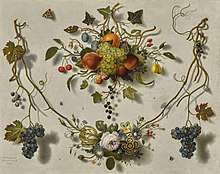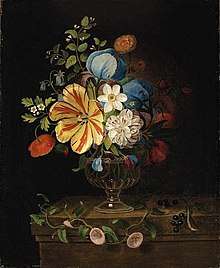Martin van Dorne
Martin van Dorne or Martinus Vandorne[1][2] (Leuven, baptized on 22 January 1736 - Leuven, 2 May 1808) was a Flemish painter and poet of the 18th-century, specialized in still lifes.[3] He is known for his still lifes of fruit and flower. He was nominated court painter by Prince Charles Alexander of Lorraine, the governor of the Austrian Netherlands. He was also a poet in the Dutch language.[4]

Life
Martin van Dorne was the son of Amandus van Dorne and Elisabetha Annosset.[3] Nothing is known about his training and early career. It is possible that he was self-taught. He was established in his hometown as a painter of floral still lifes and gained a regional reputation. Possibly, like many contemporaries, he was also working as a decorative painter.[4]

He married Petronilla Ekermans on 25 February 1765. Of their children a son called Frans (10 April 1776-30 November 1848) became an esteemed portrait painter.
Prince Charles of Lorraine, governor of the Austrian Netherlands appointed van Dorne as an ordinary painter, by letters patent dated 5 August 1779.[4] In October 1800 van Dorne was, together with Pieter-Jozef Verhaghen, François Xavier Joseph Jacquin, Josse-Pieter Geedts, Frans Berges, Pieter Goyers and Antoon Clevenbergh, a co-founder of the Academy of Leuven.[5]
Van Dorne was an amateur poet who composed occasional poetry at family feasts and meetings of artists. On the return to Belgium of the history painter Pieter-Jozef Verhaghen, who was also his friend, he described in a short didactic poem, all the works executed by the prolific artist Verhaghen.[4]
He died in the Civil Hospital of Leuven on 2 May 1808.[5]
Work
Martin van Dorne mainly painted still lifes with flowers, butterflies and fruit. These works continue the late baroque tradition of Flemish still life painters such as Jan Baptist Bosschaert. A pair of still lifes in the M – Museum Leuven show still lifes of flowers in a vase on a pedestal with a view of a landscape in the background. There is also some fruit on the pedestal.[5]
References
- Also referred to as Marten van Dorne
- F. Marten van Dorne in: Jos. van den Branden en J.G. Frederiks, Biographisch woordenboek der Noord- en Zuidnederlandsche letterkunde, 1888-1891 (in Dutch)
- Martin van Dorne at the Netherlands Institute for Art History (in Dutch)
- Félix Stappaerts, Martin van Dorne in: Biographie nationale de Belgique (in French)
- Karen Andree, Van voor Teniers tot na Ensor: Collectie Noordbrabants Museum te gast, M van Museum Leuven, 2012, p. 65 (in Dutch)
External links
![]()